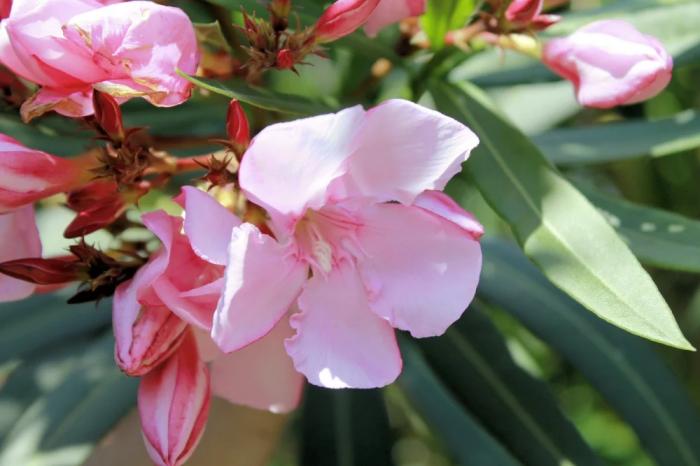In a significant health and safety measure, the United Arab Emirates (UAE) has enacted a ban on the use of the Oleander flower, commonly known as ‘Arali.’ This decision comes in the wake of a tragic incident in May involving a young woman from Alappuzha, India, who died after accidentally ingesting poison from the plant. The flower, often used in religious ceremonies and celebrations, has now been flagged for its potential dangers, prompting authorities to take action to protect public health.
Tragic Incident Sparks Alarm
The incident that raised awareness about the dangers of the Oleander flower involved 24-year-old Surya Surendran, who lost her life after mistaking the plant for a harmless flower in her courtyard. According to police reports, the ingestion of the poison caused Surendran to suffer a cardiac arrest. This shocking event led to widespread concern, particularly in Kerala, where the flower is commonly used for various rituals and ceremonies, including pujas in temples.
In response to the incident, both the Travancore and Malabar Devaswom Boards, which oversee temple activities in Kerala, have prohibited the use of Oleander in temple offerings. This decision reflects a growing awareness of the flower’s toxicity and the risks associated with its use in religious and cultural practices.
UAE’s Proactive Measures
Following the incident in India, the UAE has also taken decisive action against the Oleander flower. Reports from Manorama Online indicate that the UAE has banned the sale and use of the flower, imposing severe penalties for those found in violation of this regulation. The flower, which was previously popular in the UAE for Onam celebrations, floral carpet making, and other religious ceremonies, has now been deemed too dangerous for public use.
The ban aims to protect residents and visitors from the toxic effects of the Oleander plant, which has long been a staple in floral arrangements and cultural events. Authorities are urging the public to refrain from using the flower in any capacity to prevent similar incidents from occurring.
The Dangers of Oleander
Experts have long recognized the Oleander flower as highly toxic. The plant, known as ‘kaajamaaraka’ in Sanskrit, translates to “one that can kill a horse.” This alarming designation underscores the seriousness of the poison contained in all parts of the plant, particularly its leaves. Botanists warn that the current climate conditions can exacerbate the toxicity of Oleander, making it even more dangerous.
According to medical experts, the ingestion of Oleander can have severe consequences. The poison can significantly slow down cardiac function, ultimately leading to cardiac arrest. It also poses threats to other vital organs; toxins from the flower can damage the lungs and liver, disrupt blood clotting, cause breathing difficulties, and even result in liver bleeding. The toxicity of Oleander is alarmingly potent—research indicates that the poison acts approximately one-third as quickly as potassium cyanide.
Emergency Responses and First Aid
In the event of accidental ingestion, experts suggest immediate first aid measures. Although the situation can be life-threatening, buttermilk or lime juice can be administered as a preliminary treatment for those who have consumed Oleander. These remedies may help to mitigate some of the poison’s effects while awaiting professional medical assistance.
It is essential to recognize that even with first aid, the ingestion of Oleander requires immediate medical attention. Emergency services should be contacted without delay to provide appropriate treatment, as the plant’s toxicity can lead to rapid deterioration in health.
Cultural Significance vs. Safety Concerns
The Oleander flower has deep cultural significance in various regions, especially in India, where it is often associated with rituals and celebrations. Its vibrant appearance and fragrant scent have made it a popular choice for floral arrangements. However, as the recent incident highlights, the cultural and aesthetic value of the flower must be weighed against the serious health risks it poses.
Authorities in both India and the UAE are urging communities to explore safer alternatives for floral displays and religious offerings. By promoting awareness and educating the public about the dangers of Oleander, they hope to prevent future tragedies and ensure that cultural practices can continue safely.
The Need for Increased Awareness
The ban on Oleander in the UAE serves as a critical reminder of the need for heightened awareness regarding the use of potentially toxic plants in everyday life. As people engage in cultural practices, it is crucial to prioritize safety and make informed choices about the flora used in these traditions.
Community education initiatives could play a pivotal role in informing residents about the risks associated with certain plants. Workshops, seminars, and informational campaigns could empower individuals to make safer decisions regarding the flowers and plants they choose to incorporate into their celebrations.
Conclusion
The tragic loss of Surya Surendran has not only sparked a ban on Oleander in the UAE but has also ignited a broader conversation about plant safety and public health. As authorities take proactive measures to protect their communities, the incident serves as a poignant reminder of the potential dangers that can lurk in even the most seemingly innocuous flowers.
By raising awareness, promoting safer alternatives, and educating the public about the risks associated with toxic plants, we can work together to prevent future tragedies and ensure the safety of our communities. The ban on Oleander is a crucial step in this direction, reflecting a commitment to public health and the well-being of all residents.
Related topics:


